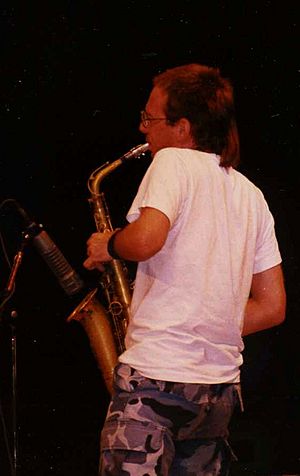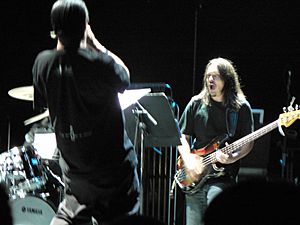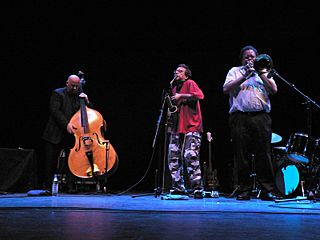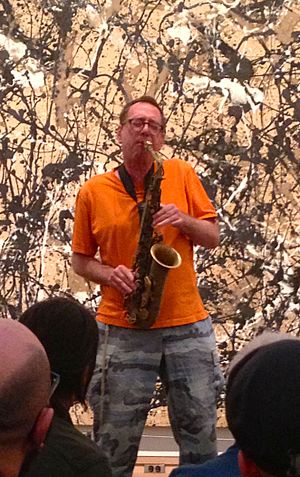John Zorn facts for kids
Quick facts for kids
John Zorn
|
|
|---|---|
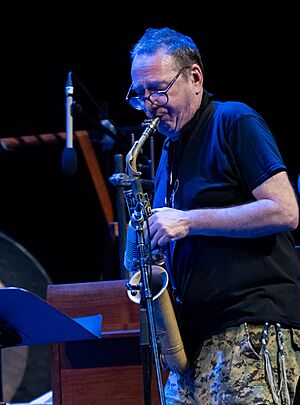
Zorn in 2023
|
|
| Background information | |
| Born | September 2, 1953 New York City, U.S. |
| Genres |
|
| Occupation(s) | Musician, composer, producer, arranger |
| Instruments |
|
| Years active | 1973–present |
| Labels | Tzadik, Avant, DIW, Elektra Nonesuch, Earache, Hathut, Shimmy-Disc, Eva, Toy's Factory, Nato, Lumina, Black Saint, Subharmonic, Parachute, Yukon, Rift |
John Zorn (born September 2, 1953) is an American musician, composer, and producer. He is known for his unique and experimental approach to music. Zorn combines many different styles, like jazz, rock, Jewish music, hardcore, and classical. Rolling Stone magazine has called him one of the most important musicians of our time.
Zorn became active in the New York City music scene in the mid-1970s. He worked with other artists and tried out new ways to compose and perform music. He traveled and performed in Europe and Japan, releasing music on independent labels. In 1986, he gained fame with his album The Big Gundown. This album reimagined themes from Ennio Morricone's movie scores. Zorn's later albums, Spillane and Naked City, also showed his skill at mixing different music styles.
In 1995, Zorn started his own record label, Tzadik, in New York. This allowed him to have full control over his music and release many new albums each year. He also released music by other artists. Zorn plays the saxophone in his bands like Naked City, Painkiller, and Masada. He also leads groups like Moonchild and Simulacrum. Zorn has written music for classical orchestras, operas, films, and art installations. He often performs at music festivals around the world.
Contents
Early Life and Musical Journey
Growing Up and Learning Music
John Zorn grew up in Utopia, Queens, New York. He learned to play piano, guitar, and flute at the United Nations International School. His mother enjoyed classical and world music. His father liked jazz, French songs, and country music. Zorn's older brother collected doo-wop and 1950s rock and roll records. As a teenager, Zorn listened to The Doors and played bass in a surf band. He also explored experimental music by composers like György Ligeti and Karlheinz Stockhausen. He enjoyed listening to cartoon and film soundtracks.
Zorn taught himself how to arrange music and write different musical parts by studying existing scores. He also took composition lessons from Leonardo Balada. At Webster College, he attended talks by Oliver Lake. During this time, Zorn started combining free jazz, experimental music, film scores, and cartoon scores into his own early recordings. He was inspired by Anthony Braxton's solo saxophone album For Alto to start playing the saxophone himself. Zorn wanted to work directly with musicians, saying, "I have to be there with them... so that I could meet musicians."
After college, Zorn moved back to Manhattan. He performed in his apartment and other small venues. He played saxophone, other wind instruments, and used duck calls and tapes. Zorn was very involved in the underground art scene. He helped filmmaker Jack Smith and attended plays by Richard Foreman.
Early Compositions and Recordings
Zorn's early major compositions were often called "game pieces." These pieces had "complex systems" that guided improvising musicians. They used strict rules, role-playing, and flashcards to mix structure and improvisation. His early game pieces had sports-related titles like Lacrosse (1976) and Hockey (1978). He recorded these on the Parachute label. His most famous game piece is Cobra, which he composed in 1984. It has been recorded and performed many times since.
In the early 1980s, Zorn focused on improvisation, both alone and with other artists. His first solo saxophone recordings were released as The Classic Guide to Strategy in 1983 and 1986. His early group improvisations are on Locus Solus (1983). This album featured Zorn with musicians like Christian Marclay and Ikue Mori. Another album, Ganryu Island (1984), featured duets with Michihiro Sato playing the shamisen. Zorn has re-released these early recordings.
Breakthrough Recordings
Zorn's big breakthrough came in 1986 with The Big Gundown. Composer Ennio Morricone praised the album, saying it had "fresh, good and intelligent ideas."
Zorn followed this with Spillane in 1987. This album featured famous musicians like Albert Collins and the Kronos Quartet. The main song on the album used Zorn's "file-card" method of composing. This method involved Zorn writing musical ideas on small cards and then arranging them to create the piece. He described it as "writing in moments, in disparate sound blocks." He would work for many hours arranging these cards.
Zorn's file-card method relied on the musicians' interpretations and their relationship with him. He wanted players to feel that the hard work was "worth the effort." After Spillane, Zorn released three more albums on the Nonesuch label: Spy vs Spy (1989), Naked City (1990), and Filmworks 1986–1990 (1992).
John Zorn's Music Styles
Jazz Explorations
Zorn explored jazz music directly in albums like Voodoo (1986), which honored composer Sonny Clark. He also formed the News for Lulu trio, playing songs by jazz legends like Clark and Kenny Dorham. In 1989, he recorded Spy vs Spy, which featured hardcore punk versions of Ornette Coleman's jazz compositions.
Music for Films
Zorn hoped to compose for Hollywood films after The Big Gundown was released. While Hollywood didn't call, independent filmmakers like Sheila McLaughlin and Raúl Ruiz asked for his music. Filmmaker Walter Hill didn't use Zorn's music for his film Looters. However, Zorn used the money he received to start his record label, Tzadik. On Tzadik, he released Filmworks II: Music for an Untitled Film by Walter Hill in 1995.
Zorn also created music for commercials, including one directed by Jean-Luc Godard. He used his film music projects to record new groups like Masada and the Masada String Trio. From the mid-1990s, Zorn composed film music for independent movies about different cultures and experiences, documentaries about Jewish life, and films about unique artists. In 2013, after releasing 25 volumes in his Filmworks Series, Zorn announced he would no longer release music for films.
Hardcore: Naked City, Painkiller, and Moonchild
In 1988, Zorn formed Naked City as a "compositional workshop." He wanted to see how far he could push the limits of a rock band. The band included Zorn (saxophone), Bill Frisell (guitars), Fred Frith (bass), Wayne Horvitz (keyboards), Joey Baron (drums), and vocalist Yamatsuka Eye (later Mike Patton). Naked City mixed Zorn's love for hardcore punk and grindcore with film music, country, or jazz, often in one song. They played pieces by film composers like Ennio Morricone and modern classical composers like Charles Ives. They also recorded heavy metal and ambient albums.
In 1991, Zorn started Painkiller with Bill Laswell on bass and Mick Harris on drums. Painkiller's first two albums, Guts of a Virgin (1991) and Buried Secrets (1992), had short, fast songs inspired by grindcore and free jazz. Their album Execution Ground (1994) featured longer, more relaxed pieces. Both Naked City and Painkiller became very popular, especially in Japan.
In 2006, Zorn formed Moonchild, a trio with Mike Patton (voice), Trevor Dunn (bass), and Joey Baron (drums). Zorn wanted to create "songs without words" for Patton's wide vocal range. Rolling Stone magazine noted that Moonchild, like Naked City, changed a lot over time as Zorn kept challenging himself with new compositions.
Classical Concert Music
As Zorn's interest in Naked City changed, he started thinking about classical music again. He began creating compositions for classical instruments like strings, percussion, and electronic instruments. Elegy, a suite dedicated to writer Jean Genet, was released in 1992.
When he started Tzadik Records, Zorn could release many classical compositions he had written over the years. His earliest released classical piece, Christabel (1972) for five flutes, appeared on Angelus Novus in 1998. He credits his 1988 string quartet Cat O' Nine Tails with opening his eyes to writing for classical musicians. This piece was recorded by the Kronos Quartet.
Aporias: Requia for Piano and Orchestra (1998) was Zorn's first full orchestral album. It featured pianist Stephen Drury and the American Composers Orchestra. Many of Zorn's classical works are dedicated to or inspired by artists who influenced him. For example, Duras: Duchamp (1997) honored Marguerite Duras and Olivier Messiaen. Songs from the Hermetic Theatre (2001) featured pieces dedicated to Harry Smith and Joseph Beuys.
Later works included vocal and operatic pieces. Mysterium (2005) featured a piece for female chorus. Rituals (2005) included Zorn's opera, which premiered at the Bayreuth Opera Festival in 1998. Zorn's classical works have been performed worldwide, and he has received commissions from major groups like the New York Philharmonic.
Masada Music
Conversations with drummer Joey Baron led Zorn to explore Jewish culture. His composition Kristallnacht (1992) reflected on the "Night of Broken Glass" in 1938, when Jews in Germany and Austria were attacked. This piece used musical scales common in klezmer music. Zorn then challenged himself to write 100 compositions using these scales within a year.
Book One
In 1993, Zorn formed the first Masada group with Baron, Dave Douglas (trumpet), and Greg Cohen (double bass). They performed his new compositions, using a similar style to Ornette Coleman's free jazz quartet.
Within three years, Zorn had written 205 compositions, which became known as the first Masada Book. Zorn explained that the Masada project was about creating something positive in the Jewish tradition. He wanted to bring Jewish music into the 21st century.
In 1996, Zorn released Bar Kokhba, featuring Masada compositions played by different musicians. Two groups came from this album: the Masada String Trio and the Bar Kokhba Sextet. The Masada String Trio appeared on Zorn's film music series and other albums. In 2003, Zorn formed Electric Masada, a larger band that included electronics and keyboards. In 2019, Zorn started the New Masada Quartet.
In 2003, Zorn released a Tenth Anniversary Series of Masada recordings. These included albums like Masada Guitars by Marc Ribot and Masada Recital by Mark Feldman.

Book Two
In 2004, Zorn began composing the second Masada Book, called The Book of Angels. This resulted in 316 more compositions. Zorn said he wrote 100 songs in the first month, then another 100, and a third 100 in the third month.
Zorn released 32 albums of Masada Book Two compositions, performed by many different artists. The titles of many of these songs come from demonology and Judeo-Christian mythology.
The original Masada quartet performed their final concerts in March 2007. However, Zorn reformed the band as a sextet in 2009, adding Uri Caine and Cyro Baptista. He said it was a "magical click" when they played together. Zorn's Masada compositions are now a main focus of many concerts and festivals. He often holds "Masada Marathons" where various bands play music from the Masada Books.
Book Three
Zorn finished the third Masada book, called The Book Beriah, in 2014.
The Dreamers
In 2001, Zorn released The Gift, one of his most popular albums. It surprised many with its relaxed mix of surf, exotica, and world music. In 2008, Zorn premiered The Dreamers, which returned to the gentle style of The Gift. This led to the formation of the band of the same name. The Dreamers released their second album, O'o, in 2009, and a Christmas album in 2011.
Other Important Work
Tzadik Records
In 1992, John Zorn helped manage the Avant subsidiary of the DIW label. He released several Naked City recordings and albums by other musicians like Derek Bailey and Dave Douglas.
In 1995, Zorn started his own label, Tzadik. This allowed him to record and release his growing collection of music and works by others. Zorn felt it was easier to be creative without the pressures of big record companies.
Tzadik's releases are organized into different series:
- The Archival Series features Zorn's own recordings, including re-releases and film music.
- The 50th Birthday Celebration Series includes 11 live albums from concerts in 2003.
- The Composer Series features Zorn's classical music and works by other modern composers.
- The Radical Jewish Culture Series highlights contemporary Jewish musicians.
- The New Japan Series covers Japanese underground music.
- The Film Music Series features soundtracks by other musicians.
- The Oracle Series promotes women in experimental music.
- The Key Series presents notable avant-garde musicians.
- The Lunatic Fringe Series releases music that doesn't fit other categories.
- The Spotlight Series promotes new bands and young musicians.
Tzadik also releases special CDs, DVDs, books, and T-shirts. Since 1998, graphic artist Heung-Heung "Chippy" Chin has designed Tzadik's releases.
The Stone Music Venue
Zorn's first performances in New York were in small art spaces, including his own apartment. As he became more famous, he performed at alternative venues like the Knitting Factory and Tonic. In 2007, Zorn played the last night at Tonic before it closed.
Zorn was a key person in creating The Stone in 2005. This is an experimental music venue in New York City. It operates only on donations and sales of limited-edition CDs. All money from ticket sales goes directly to the performers. Zorn is the artistic director and often performs "Improvisation Nights" there. He likes that The Stone doesn't have a bar, so there's no pressure to attract a drinking crowd. On January 10, 2008, Zorn performed with Lou Reed and Laurie Anderson at a special benefit night at The Stone. In 2018, The Stone moved to The New School in Greenwich Village.
Birthday Concert Series
In September 2003, Zorn celebrated his 50th birthday with a month-long series of performances at Tonic in New York. He organized the month to showcase different parts of his music. His bands played on weekends, classical groups on Sundays, and Zorn performed improvisations with other musicians on Mondays. A total of 12 live albums were released from his 50th Birthday Celebration Series.
Zorn's 60th birthday celebrations took place around the world in 2013 and 2014. Concerts were held at festivals, art galleries, and unique venues. The first concerts were at the Walker Art Center in Minneapolis in April 2013. This was followed by performances at the Museum of Modern Art and Solomon R. Guggenheim Museum. The European part of the celebration started at the Barbican Theatre in London in July 2013. Festivals in Belgium, Poland, Spain, and Germany followed.
Back in New York City, Zorn performed at Alice Tully Hall and Lincoln Centre. He also held another Masada Marathon at the Skirball Center for the Performing Arts in August. More New York concerts in September included film music at the Anthology Film Archives, classical works at the Miller Theatre, and a day-long concert at the Metropolitan Museum of Art. He also performed improvised duets with Ryuichi Sakamoto. The final Zorn@60 concerts were part of the Adelaide Festival in Australia in March 2014.
Arcana Book Series
In 2000, Zorn edited the book Arcana: Musicians on Music. This book featured interviews, essays, and comments by musicians like Bill Frisell and Mike Patton. They shared their ideas about how they compose music. Zorn released the second volume of Arcana in 2007, saying it was needed to share "radical, cutting-edge ideas about music." New volumes have been released since then, with the eighth volume published in 2017.
In Other Media
Zorn appeared in the 1985 film Money by Henry Hills. This film was about the financial challenges faced by avant-garde artists in Manhattan during the 1980s.
Awards and Recognition
In 2001, John Zorn received the Jewish Cultural Award in Performing Arts. In 2006, he was named a MacArthur Fellow, which is a special award for talented individuals. In 2007, he received the William Schuman Award from Columbia University. This award recognizes American composers whose works are widely performed and considered important for a long time.
In 2011, Zorn was inducted into the Long Island Music Hall of Fame by Lou Reed. He also received an honorary degree from the University of Ghent. In 2014, he received honorary doctorates from The State University of New York and the New England Conservatory of Music.
Filmography
- Money (1985), a film by Henry Hills about the early downtown improvised music scene.
- Put More Blood Into the Music (1987), a documentary about New York avant-garde music.
- Step Across the Border (1990), a documentary about Fred Frith.
- A Bookshelf on Top of the Sky: 12 Stories About John Zorn (Tzadik, 2004), a film about John Zorn.
- Masada Live at Tonic 1999 (2004), a concert film.
- Celestial Subway Lines / Salvaging Noise (2005), an experimental documentary with music by Zorn and Ikue Mori.
- Sabbath in Paradise (Tzadik, 2007), a documentary about Jewish music in New York's avant-garde jazz scene.
- Astronome: A Night at the Opera (2010), an opera by Richard Foreman with music by John Zorn.
- Zorn I (2016) by Mathieu Amalric
- Zorn II (2018) by Mathieu Amalric
- Zorn III (2022) by Mathieu Amalric
See also
 In Spanish: John Zorn para niños
In Spanish: John Zorn para niños


